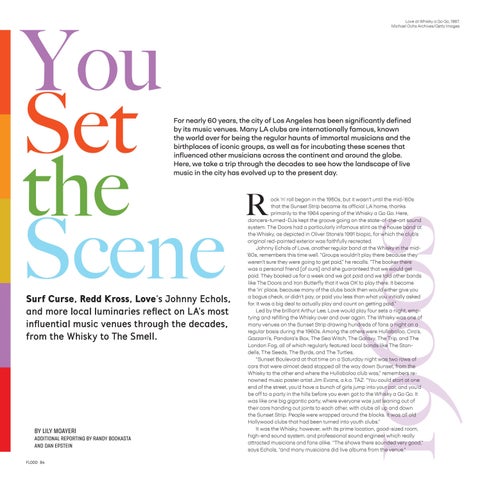You Set the Scene
Love at Whisky a Go Go, 1967. Michael Ochs Archives/Getty Images
For nearly 60 years, the city of Los Angeles has been significantly defined by its music venues. Many LA clubs are internationally famous, known the world over for being the regular haunts of immortal musicians and the birthplaces of iconic groups, as well as for incubating these scenes that influenced other musicians across the continent and around the globe. Here, we take a trip through the decades to see how the landscape of live music in the city has evolved up to the present day.
BY LILY MOAYERI ADDITIONAL REPORTING BY RANDY BOOKASTA AND DAN EPSTEIN FLOOD 84
196os
Surf Curse, Redd Kross, Love’s Johnny Echols, and more local luminaries reflect on LA’s most influential music venues through the decades, from the Whisky to The Smell.
R
ock ’n’ roll began in the 1950s, but it wasn’t until the mid-’60s that the Sunset Strip became its official LA home, thanks primarily to the 1964 opening of the Whisky a Go Go. Here, dancers-turned-DJs kept the groove going on the state-of-the-art sound system. The Doors had a particularly infamous stint as the house band at the Whisky, as depicted in Oliver Stone’s 1991 biopic, for which the club’s original red-painted exterior was faithfully recreated. Johnny Echols of Love, another regular band at the Whisky in the mid’60s, remembers this time well. “Groups wouldn’t play there because they weren’t sure they were going to get paid,” he recalls. “The booker there was a personal friend [of ours] and she guaranteed that we would get paid. They booked us for a week and we got paid and we told other bands like The Doors and Iron Butterfly that it was OK to play there. It became the ‘in’ place, because many of the clubs back then would either give you a bogus check, or didn’t pay, or paid you less than what you initially asked for. It was a big deal to actually play and count on getting paid.” Led by the brilliant Arthur Lee, Love would play four sets a night, emptying and refilling the Whisky over and over again. The Whisky was one of many venues on the Sunset Strip drawing hundreds of fans a night on a regular basis during the 1960s. Among the others were Hullabaloo, Ciro’s, Gazzarri’s, Pandora’s Box, The Sea Witch, The Galaxy, The Trip, and The London Fog, all of which regularly featured local bands like The Standells, The Seeds, The Byrds, and The Turtles. “Sunset Boulevard at that time on a Saturday night was two rows of cars that were almost dead stopped all the way down Sunset, from the Whisky to the other end where the Hullabaloo club was,” remembers renowned music poster artist Jim Evans, a.k.a. TAZ. “You could start at one end of the street, you’d have a bunch of girls jump into your car, and you’d be off to a party in the hills before you even got to the Whisky a Go Go. It was like one big gigantic party, where everyone was just leaning out of their cars handing out joints to each other, with clubs all up and down the Sunset Strip. People were wrapped around the blocks. It was all old Hollywood clubs that had been turned into youth clubs.” It was the Whisky, however, with its prime location, good-sized room, high-end sound system, and professional sound engineer which really attracted musicians and fans alike. “The shows there sounded very good,” says Echols, “and many musicians did live albums from the venue.”
